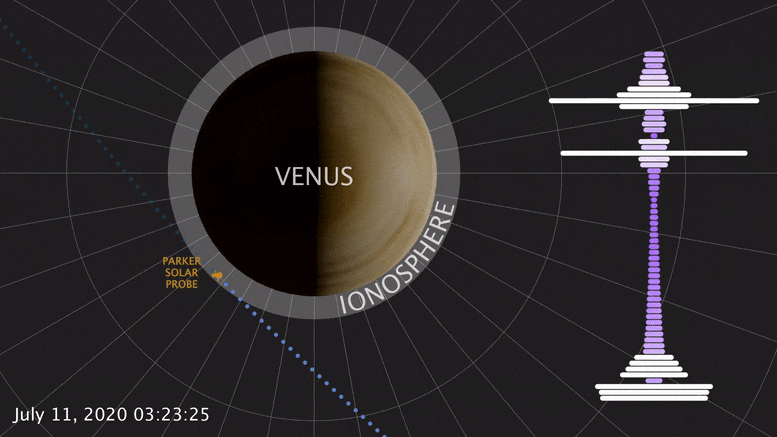
A study published today confirms that Venus’ upper atmosphere undergoes puzzling changes over a solar cycle, the Sun’s 11-year activity cycle.
On July 11, 2020, Parker Solar Probe swung by Venus in its third flyby.The data sonification in the video translates data from Parker Solar Probe’s FIELDS instrument into sound.
FIELDS detected a natural, low-frequency radio emission as it moved through Venus’ atmosphere that helped scientists calculate the density of the planet’s electrically charged upper atmosphere, called the ionosphere.
For just seven minutes — when Parker Solar Probe was closest to Venus — FIELDS detected a natural, low-frequency radio signal.
Like Earth, Venus sports an electrically charged layer of gas at the upper edge of its atmosphere, called the ionosphere.When Collinson and his team identified that signal, they realized Parker Solar Probe had skimmed Venus’ upper atmosphere — a pleasant surprise, though one they might have expected based on previous data, he said.
The researchers used this radio emission to calculate the density of the ionosphere that Parker Solar Probe flew through.Researchers last obtained direct measurements of Venus’ ionosphere from Pioneer Venus Orbiter in 1992.
While the bulk of the atmosphere remained the same, the ionosphere — which is at the top, where gases can escape to space — was much thinner during solar minimum.
During its third Venus flyby on July 11, 2020, Parker Solar Probe’s WISPR imager captured this view of Venus’ nightside from 7,693 miles away.The observations from Parker Solar Probe’s recent flyby, which occurred six months after the latest solar minimum, verify the puzzle in Venus’ ionosphere.Indeed, Venus’ ionosphere is much thinner compared to previous measurements taken during solar maximum.
Understanding why Venus’ ionosphere thins near solar minimum is one part of unraveling how Venus responds to the Sun — which will help researchers determine how Venus, once so similar to Earth, became the world of scorching, toxic air it is today.“The goal of flying by Venus is to slow down the spacecraft so that Parker Solar Probe can dive closer to the Sun,” said Nour E.
Raouafi, Parker Solar Probe project scientist at the Applied Physics Laboratory.
Venus scientists were eager to piggyback off Parker Solar Probe’s flyby for new data and views of Earth’s twin planet.
Reference: “Depleted Plasma Densities in the Ionosphere of Venus Near Solar Minimum From Parker Solar Probe Observations of Upper Hybrid Resonance Emission” by Glyn A.No, its the Parker solar probe, when it enters into the ionosphere